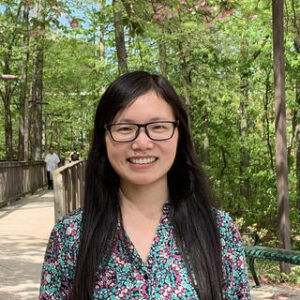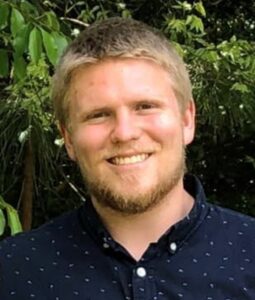-

Xiaoyan Tan
There’s a lot of energy in the field of energy these days. One specific area that attracts much attention is in thermoelectric materials, which transforms heat into electricity or converts electricity into cooling technology for power generators or refrigeration. There’s also another appeal in thermoelectric materials — their ability to generate electricity from waste heat released by spacecraft, motor vehicles, and industrial plants — a positive checkmark in the environmentally friendly ‘green’ movement. Drilling down this issue even further is the area of polar thermoelectrics. The reality in this field, is that fundamental mechanisms which govern the thermoelectric properties in this class of materials are not fully understood.
Gaining a greater awareness of polar thermoelectrics has long intrigued Xiaoyan Tan, Assistant Professor in Mason’s Chemistry and Biochemistry Department. Tan’s research focus is the discovery of functional and multifunctional inorganic solid-state materials, ranging from intermetallics to oxides, with applications in technology and energy conversion. Tan foresaw the benefits of using density functional theory (DFT) calculations to understand these polar thermoelectric materials better and predict novel polar thermoelectrics. She also saw possible options to expand her research in the field with two other 4-VA schools – UVA and JMU. Tan recognized these routes after reading several of Dr. Prasanna Balachandran’s (UVA) papers and meeting Dr. Masoud Kaveh-Baghbadorani (JMU) at the National Science Foundation Faculty Early Career Development Program.
-

Prasanna Balachandran
-

Masoud Kaveh-Baghbadorani
Tan also saw a valuable opportunity for Mason students to learn DFT calculations from Balachandran and to learn how to characterize materials using the second harmonic generation technique from Kaveh-Baghbadorani, which were not available to Mason students. Tan envisioned that a collaborative research grant from 4-VA@Mason and 4-VA Complementary Grants, available at UVA and JMU, could provide the opening to engage in the shared research.
With the grants awarded and in hand, Tan initialized her plan: Mason students would first synthesize thermoelectric materials, determine the crystal structure, and measure the low-temperature thermoelectric properties. The prepared samples would then be sent to JMU to measure the second harmonic generation properties. Faculty and students from UVA would undertake the majority of theoretical DFT calculations of electronic structure and thermoelectric properties, providing the theoretical understanding of the measured ultra-low thermal conductivity data. Based on knowledge learned from UVA, Mason students compare the experimental results with theoretical results. In addition to the collaboration with UVA and JMU, the team also collaborated with Prof. Susan Kauzlarich at UC-Davis, who assisted with high temperature thermoelectric properties.
With limited access due to pandemic shutdowns, Tan found it initially challenging to manage this research plan. However, the group made do and got to work. Mason PhD candidate Callista Skaggs (pictured in featured image with her poster) was responsible for synthesizing the pure compounds, the characterization of thermoelectric properties at low temperature, and data analysis of obtained results. “I met with the UVA team over Zoom to discuss the project,” says Skaggs. “Each meeting would increase our overall understanding of the compound, allowing each group to discuss what they were doing in data analysis. These meetings allowed the groups to have a better understanding of the project as a whole and to keep the project on track.”
-

Zachary Messegee
Mason PhD graduate student Zachary Messegee says that working on the project provided an invaluable education. “I learned new instrumentation techniques and got the understanding behind the measurements,” Messegee adds, “During the project, we tried a couple of novel techniques in our lab, and now these experiences and understandings can be replicated for future research activities and passed along to other new members of the group.”
Messegee further explains, “I was responsible for measuring the optical properties of the compounds that Callista prepared and performed data analysis and corresponding figures for publication.” Messegee also benefited from an additional perk on the project, students completing their degrees at Mason were able to attend the “Introduction to Materials Informatics” class taught by Balachandran at UVA. Students learned about machine learning and DFT calculations, which equally expanded knowledge and skills.
The collaboration was appreciated by both students and faculty. As Kaveh-Baghbadorani notes, “First and foremost, this project was a great collaboration with an enthusiastic researcher like Dr. Tan. I found the project an enthralling topic with great potential. In addition, through this project, an undergraduate researcher here at JMU found an opportunity to start learning about a cutting-edge topic.”
And the research has paid off. Says Tan, “We have successfully identified two promising thermoelectric materials Ag2GeS3 and Ag10Ge3S11. A phase-pure polycrystalline Ag2GeS3 sample has been prepared, and the polar crystal structure and low thermoelectric has been confirmed.” The results were enthusiastically received at the American Physical Society Spring 2022 meeting, the American Chemical Society (ACS) Spring 2021 meeting, and the North American Solid State Chemistry Conference (Summer 2021), where Skaggs won third place in the poster presentation. The results of this project have been published in a high impact ACS Journal, Chemistry of Materials (https://doi.org/10.1021/acs.chemmater.2c01050)

- Skagg’s Third Place Poster
“This was a great experience!” says Skaggs. “I was able to meet professionals in my field and discuss my research with them. They were able to give suggestions on different analysis techniques and characterization methods, that I was unfamiliar with, that could improve my understanding of the material. Winning third place was a shock – it was gratifying to see that the research I and others had done was valued so highly.”
Balachandran’s take on the project echoed the benefits of the exchange of ideas, “Our group enjoyed the interactions with PI Prof. Tan’s group at GMU. I believe that we understood the strengths and weaknesses of our research capabilities better, which is crucial as we transition to writing collaborative grants. Without this funding, we would not have had a clear path to have generated sufficient preliminary data for a publication and demonstrate that our groups collaborate well.”
Kaveh-Baghbadorani concludes, “There might have been a day, hundreds to thousands of years ago, that scientists and philosophers would sit in a corner and write about their thoughts. That model is destined to fail these days. Great scientific discoveries happen through diverse collaborations. Collaboration with other schools is an inseparable part of conducting any kind of research, that leverages the strength of each partner university and improves efficiencies in higher education. We are thankful for 4-VA at JMU and GMU for promoting this partnership.”
